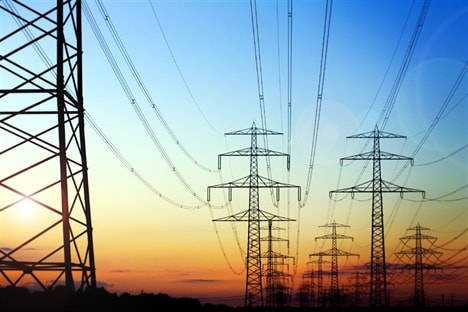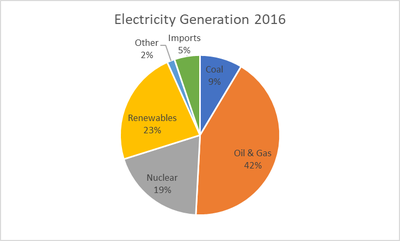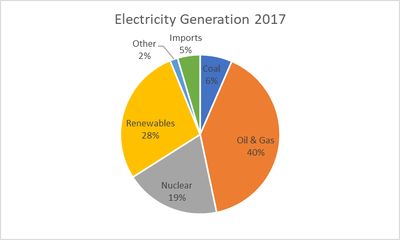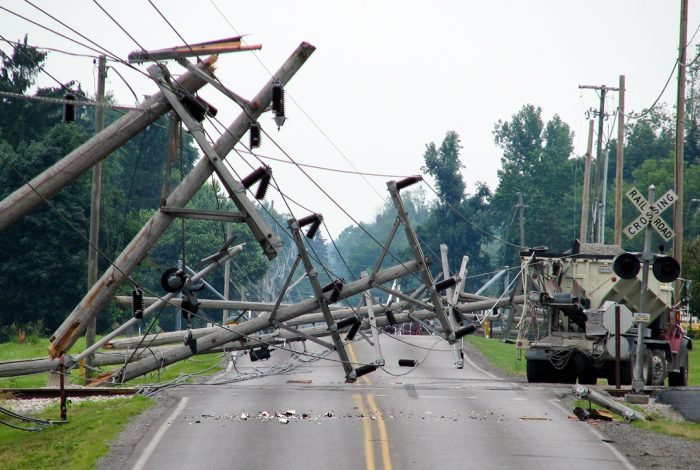Supply
In the UK electricity is supplied to households and businesses via the national grid. AC electricity is transformed down to around 230V, 50 Hz for domestic consumers and in general is single phase. Electricity is transmitted through the UK via transmission and distribution lines with 3 phase voltages of 400kV and 275kV for transmission and lower voltages of 33kV and 11kV for distribution. The transmission and distribution networks in Scotland are regulated by SSE and Scottish Power with supply coming from many different generation sources and being transported to locations with electricity demand.
Currently, the composition of electricity supply is changing as the UK makes a move to more carbon free electricity sources. Renewable generation plants tend to be further from major cities than coal or gas plants historically were located, this means the peak capacity of the transmission and distribution lines is being disturbed, with more remote power lines needing to be capable of delivering more power or for longer distances.
In 2016 the Ofgem records show that the Electricity grid was still heavily dependent on fossil fuel generation, with 51% of generation from Oil, Gas or Coal. In contrast to this figure in 2017 the fossil fuel generation had reduced to only 46% with renewables making up for this deficit of generation. The charts above show that progress is being made towards the 2050 coals with reducing CO2 emissions and it can be predicted that the renewable penetration of the electricity network in the UK will continue to increase.
At periods of low generation in the UK we are able to import electricity using the Irish, Dutch and French interconnectors. Interconnecting countries allows greater reliability of power networks but other issues may be introduced due to cost of energy and currency conversion as well as different grid code policies and regulations.
Moreover, with political uncertainty becoming an increasing discussion point in the UK following Brexit it may be less desirable for EU countries to trade with the UK in electricity. This increases the need for a more robust UK power grid.
At periods of low generation in the UK we are able to import electricity using the Irish, Dutch and French interconnectors. Interconnecting countries allows greater reliability of power networks but other issues may be introduced due to cost of energy and currency conversion as well as different grid code policies and regulations.
Moreover, with political uncertainty becoming an increasing discussion point in the UK following Brexit it may be less desirable for EU countries to trade with the UK in electricity. This increases the need for a more robust UK power grid.
Demand
Electricity demand is the rate at which electricity is being consumed and the demand of the UK grid is primarily dictated by consumer use. Each household in the UK has a unique peak demand and demand profile with the average UK household consuming 3,940kWh [5]. Electricity demand on a household can depend on number of residents, location, heating type, appliances and lifestyle. In general electricity demand is falling in the UK per household, however it is expected the overall demand is going to increase over the next decades with the electrification of heat and the increasing uptake of electric vehicles. [2]
The UK has had an overall reduction in industry and manufacturing with many factories being shut down. There has been a gradual switch to a much larger proportion of employment stemming from service industries e.g. financial services, engineering services. This change has seen an overall reduction in the electrical demand in despite of the gradual population increases over the past 5 decades with more than 9 million extra people residing in the UK than in 1970.
Another impact on electricity demand is the uptake of personal solar panels and small-scale wind generation methods as well as electricity provides installing smart meters on a greater scale. Consumers are becoming more aware of their own personal usage through the introduction of smart meters and it is estimated that smart meters could reduce a household’s usage by up to 17%. [6]
Another impact on electricity demand is the uptake of personal solar panels and small-scale wind generation methods as well as electricity provides installing smart meters on a greater scale. Consumers are becoming more aware of their own personal usage through the introduction of smart meters and it is estimated that smart meters could reduce a household’s usage by up to 17%. [6]
Power Quality
Power quality refers to the degree of deviation from the expected voltage and frequency expected by any given electrical load. The ideal power characteristics are when voltage and current are in phase with one another. Power quality can be compromised by harmonics on transmission lines, effect of interference on the line caused by mechanical equipment or radio frequencies. Harmonics are generally caused by generators or loads connected to the power line.
In the UK the national grid uses control and monitoring software to ensure power quality is not compromised. However, in many countries it is still difficult to ensure high power quality and this leads to outages and brown outs. Nevertheless, in the UK there are still some areas more prone to suffer power quality issues, such as highlands and islands and there are also many locations with an ever increasing reliance on power quality such as hospitals and data centres.
As the UK makes the move to low emission electricity generation it is vital that power quality is maintained as having to rely on diesel generators in instances of interruptions of power can mitigate the positive effect of generating through renewables quickly.
Another argument of increasing control of power quality is the lack of dispatchability of renewable generators, not being able to deliver the electricity to meet demand will have detrimental effects on the overall quality of power delivered by the grid.
In the UK the national grid uses control and monitoring software to ensure power quality is not compromised. However, in many countries it is still difficult to ensure high power quality and this leads to outages and brown outs. Nevertheless, in the UK there are still some areas more prone to suffer power quality issues, such as highlands and islands and there are also many locations with an ever increasing reliance on power quality such as hospitals and data centres.
As the UK makes the move to low emission electricity generation it is vital that power quality is maintained as having to rely on diesel generators in instances of interruptions of power can mitigate the positive effect of generating through renewables quickly.
Another argument of increasing control of power quality is the lack of dispatchability of renewable generators, not being able to deliver the electricity to meet demand will have detrimental effects on the overall quality of power delivered by the grid.
Balancing Mechanism
The balancing mechanism (BM) is National Grid’s method of ensuring electricity supply and demand are matched in real time. When there is an undersupply of electricity i.e. demand is higher than available supply, National Grid must purchase extra electricity generation from a supplier. Likewise, when there is an oversupply of electricity National Grid must tell a power generation plant to turn off, this normally also incurs a payment to the electricity supplier, called a constraint payment. Unlike the gas network, the electricity network cannot store energy and therefore all electricity generated must be used and supply must match demand at all times.
The balancing mechanism is done on a half hourly time basis, and this is why dynamic pricing is more likely to be implemented than other longer term balancing services such as STOR or forecasting. [8]
Intermittent generation increases the need for stricter supply demand matching due to the unpredictable nature of the generators i.e. wind power. Therefore, the balancing mechanism allows power stations to bid a monetary value of how much they would need to be paid to be taken off the grid. However, it is much harder to predict the power output of a wind farm and therefore it is more likely they will stop production of electricity than a gas plant. Also, due to the remote location of many wind farms, they are likely to be further than the high electricity demand centres of major cities. The electricity produced will have further to travel, hence greater losses, and this is another factor that may influence a decision on which power plant to curtail. [9]
The balancing mechanism is done on a half hourly time basis, and this is why dynamic pricing is more likely to be implemented than other longer term balancing services such as STOR or forecasting. [8]
Intermittent generation increases the need for stricter supply demand matching due to the unpredictable nature of the generators i.e. wind power. Therefore, the balancing mechanism allows power stations to bid a monetary value of how much they would need to be paid to be taken off the grid. However, it is much harder to predict the power output of a wind farm and therefore it is more likely they will stop production of electricity than a gas plant. Also, due to the remote location of many wind farms, they are likely to be further than the high electricity demand centres of major cities. The electricity produced will have further to travel, hence greater losses, and this is another factor that may influence a decision on which power plant to curtail. [9]
[1] https://www.parliament.uk/documents/post/pn163.pdf
[2] https://www.theguardian.com/business/2018/jan/30/uk-electricity-use-falling-economy-weather
[3] https://www.gov.uk/government/collections/digest-of-uk-energy-statistics-dukes
[4] https://www.ofgem.gov.uk/data-portal/electricity-generation-mix-quarter-and-fuel-source-gb
[5] https://www.ovoenergy.com/guides/energy-guides/how-much-electricity-does-a-home-use.html
[6] https://www.ethz.ch/content/dam/ethz/special-interest/mtec/cepe/cepe-dam/documents/education/lunch-seminar/2011-fall/NIPaper_June_2011-anna.pdf
[7] https://ac.els-cdn.com/S0378779603000671/1-s2.0-S0378779603000671-main.pdf?_tid=26ea71cf-35d7-4bce-8321-3e6162503cfd&acdnat=1525961879_636fbe876352561cbf983c17656942a6
[8] https://www.flexitricity.com/en-gb/energy-supply/balancing-mechanism/
[9] https://www.nationalgrid.com/uk/about-grid/our-networks-and-assets/how-we-balance-electricity-transmission-system
[2] https://www.theguardian.com/business/2018/jan/30/uk-electricity-use-falling-economy-weather
[3] https://www.gov.uk/government/collections/digest-of-uk-energy-statistics-dukes
[4] https://www.ofgem.gov.uk/data-portal/electricity-generation-mix-quarter-and-fuel-source-gb
[5] https://www.ovoenergy.com/guides/energy-guides/how-much-electricity-does-a-home-use.html
[6] https://www.ethz.ch/content/dam/ethz/special-interest/mtec/cepe/cepe-dam/documents/education/lunch-seminar/2011-fall/NIPaper_June_2011-anna.pdf
[7] https://ac.els-cdn.com/S0378779603000671/1-s2.0-S0378779603000671-main.pdf?_tid=26ea71cf-35d7-4bce-8321-3e6162503cfd&acdnat=1525961879_636fbe876352561cbf983c17656942a6
[8] https://www.flexitricity.com/en-gb/energy-supply/balancing-mechanism/
[9] https://www.nationalgrid.com/uk/about-grid/our-networks-and-assets/how-we-balance-electricity-transmission-system





